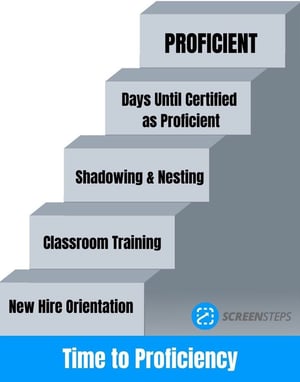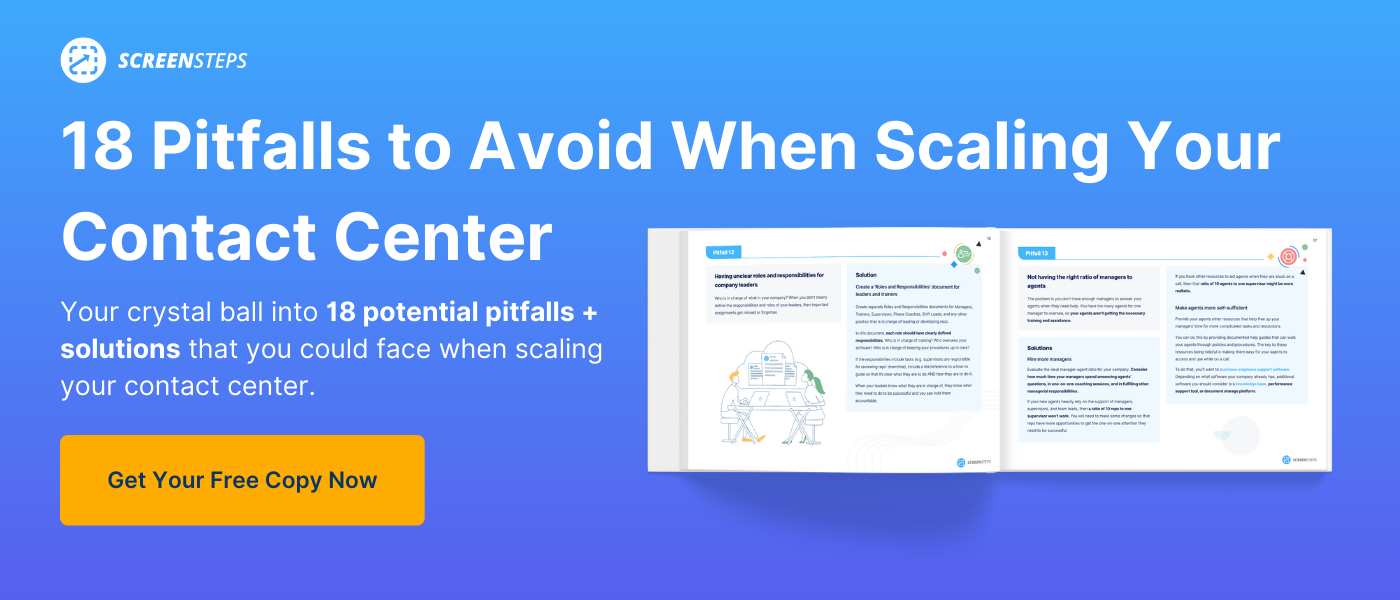What is Time to Proficiency, and How Does it Affect Your Call Center?

Call centers love metrics. We talk about QA scores, CSAT scores, Average Handle Time, Hold Time, etc.
But, how much do you know about Time to Proficiency and how it affects your call center?
As the CEO of ScreenSteps — a knowledge base software company that helps call centers store and share call flows and procedures — I've talked to many call centers that struggle with long training times. There goal is to decrease training time and mistakes, so they turn to ScreenSteps.
No matter whether you are looking at ScreenSteps for your knowledge base or you use another documenting system, this article will help anyone better understand time to proficiency.
In this article, we are going to dive deep into Time to Proficiency. First, we'll learn more about what it is. Then I'll provide you tips on calculating how long your Time to Proficiency takes and how much it costs your company.
What is Time to Proficiency?
Many people confuse Time to Proficiency with training time. While time spent in classroom training and nesting is part of your Time to Proficiency, they only make up part of the measurement.
Time to Proficiency is the number of days or weeks it takes for a new agent to become fully proficient at your call center.
What does it mean to be fully proficient? We like to define it as the following:
- They are meeting production standards in terms of Average Handle Time, QA scores, CSAT scores, and hold times.
- They are able to handle 90% of calls without asking a neighbor or manager for assistance.
Too many call centers think that Time to Proficiency is just Classroom Training Time + Nesting Time. But, that is not an accurate measurement since it only measures the training exercises you have put a new agent through.
Time to Proficiency should measure how long it takes an agent to arrive at a destination — proficiency!
It doesn’t matter how many quizzes they have passed or coaching sessions they have been through. If they aren’t hitting production metrics or they are having to constantly ask neighbors and managers for help, then they aren’t proficient yet.
🔍 Related: How to Organize Your Call Center Training Program Into 5 PhasesHow does Time to Proficiency affect the metrics in your call center?
While Time to Proficiency is just one metric, it has an impact on almost every other metric in your call center. In most cases, the longer your Time to Proficiency, the more complicated the information and processes are in your call center (unless you have implemented a Zero Memorization Training system). A longer Time to Proficiency typically means that agents need to memorize more information.
When a lot of memorization is required you will typically see increased Average Handle Times since agents will need to put callers on hold while they ask for help from a neighbor or manager. You will see decreased QA and CSAT scores as less proficient agents make mistakes.
The longer it takes for your agents to become proficient and the more agents that haven’t reached proficiency yet, the greater the drag will be on your call center metrics.
How does Time to Proficiency affect the people in your call center?
Time to Proficiency doesn’t just affect your new agents. It creates a drag on your most experienced agents and trainers as well.
Until a new agent is proficient, they will need to rely on more experienced agents or managers for help. Each time they ask a more experienced agent for help, they are decreasing the efficiency of that agent and ultimately impacting call center metrics.
Each time they have to turn to a manager for help, they are taking up valuable bandwidth from a manager that, in most cases, already has way too much to do.
It isn’t that the manager doesn’t want to help the new agent. But every time that new agent requires assistance the manager has to take time and focus away from other priorities.
If you think of your call center as a marathon runner, each agent that isn’t proficient yet is like an ankle weight slowing down the progress of the organization. Once that agent becomes proficient they can help the runner move faster with less energy. But until then, they will have a negative impact on metrics and performance.
How do you measure Time to Proficiency?
When assessing your Time to Proficiency, it is very important that you use the right criteria. If you only measure the time you spend training new agents then your numbers will not be accurate.
To get an accurate measurement, your training and management team should set clear criteria that need to be met in order to certify a new agent as proficient.

These criteria should NOT involve whether or not they pass some sort of written or interactive test. Tests do not always translate into performance. You want to measure performance, not tests.
Establish baseline metrics that need to be met in order to certify an agent as proficient. These could include Average Handle Time, Hold Time, and QA scores. You should also measure what percentage of calls they are asking for help on. Decide with your team what an acceptable number is.
Once you establish that criteria, you just count the number of days from when they first showed up for training until they are proficient. Your Time to Proficiency will include new hire orientation, classroom training time, shadowing and nesting, and then finally, the number of days after nesting until they are certified as proficient.
 What are typical Times to Proficiency for call centers?
What are typical Times to Proficiency for call centers?
The average Time to Proficiency for a call center will depend on the industry you are in. The majority of call centers we speak with have a Time to Proficiency between 4 and 8 weeks before working with us. We have spoken with some whose Time to Proficiency is as long as 6-9 months.
In most cases we find that call centers underestimate their Time to Proficiency because they are only measuring classroom, shadowing, and nesting time. They aren’t verifying that agents are hitting production metrics before they certify them.
How much does a high Time to Proficiency cost your call center?
The cost of a long Time to Proficiency can be significant. The best way to measure this is to figure out the average daily rate of a new employee. You can then multiply that number by the number of new agents and the average Time to Proficiency.
Let’s look at an example:
- Average hourly rate: $15/hour
- Average hours/day: 8
- Average daily cost/new hire: $120
- Average Time to Proficiency: 65 days
- Average cost to make one new agent proficient: $7,800
- Number of agents in current training cohort: 20
- Cost to make current cohort proficient: $156,000
This doesn’t take into account the cost of your training and management team’s time, or the drag on your more efficient agents as they assist in making new agents proficient, but it should give you a pretty good idea of what a long Time to Proficiency is really costing your organization.
🔍 Related: The True Cost of Training a New Agent in the Call Center
How can you decrease your Time to Proficiency?
As you can see from the example above, decreasing the Time to Proficiency in your call center can have a significant financial impact. If we were to take the example above and decrease the time to proficiency by 10 days we would save $24,000 with just that cohort.
There are a few levers you can pull to decrease the Time to Proficiency. They all involve reducing the amount of information an agent needs to memorize. To reduce memorization you can do one of two things:
- Make your processes so simple that they don’t require memorization
- Provide knowledge base and performance support tools that deliver the guidance and information an agent needs without requiring them to memorize any information.
1. Simplify your processes
Reducing the complexity of your processes (#1) will be the most effective. Simpler processes require less training, less memorization, and result in fewer mistakes.

But, it isn’t always possible to simplify a process.
2. Provide knowledge base and performance support tools
In cases where you don’t have control over the process or where you aren’t able to simplify in a significant way, you should look at providing knowledge base and performance support tools that will guide your agents through complex processes without the need for memorization.
These tools will make complex procedures seem simple. Since they don’t require memorization, they will dramatically decrease your Time to Proficiency.
That's because you train agents on how to find supporting documents (aka policies and procedures) so that they can follow them on calls. They don't have to remember all the details of every procedure in your company.
Find the right tools to help you decrease your Time to Proficiency
Once you determine how much time and money you are spending to bring your call center agents up to proficiency, you can begin to find solutions to decrease your Time to Proficiency.
With a ScreenSteps knowledge base, it is fast and easy for your agents to search the knowledge base, find the document they need, and follow that guide on a call. Agents don't need to put a caller on hold to find answers to their questions.
When our customers have trained agents on how to use ScreenSteps in the workflow — cutting out the expectation that agents memorize everything — they've achieved up to 90% faster training.
One call center cut training time by 75%, going from 60 days of training to just 15 days. If you would like to talk to our team for additional insights into how you can decrease your Time to Proficiency, contact us here.
However, ScreenSteps might not be the right knowledge base for your company. Before you look for a knowledge base, read this article on five tips to help you choose the right knowledge base for your business.





